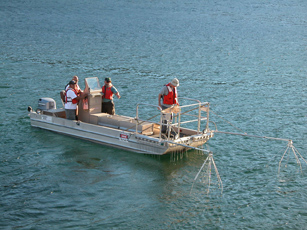Fact Sheet 2007-3026
The U.S. Geological Survey (USGS) has developed a national database and report on endocrine and reproductive condition in two species of fish collected in U.S. streams and rivers. This information provides scientists with a national basis for comparing results of endocrine measurements in fish from individual sites throughout the country, so that scientists can better ascertain normal levels of biomarkers. The database includes information on several measures of reproductive and endocrine condition for common carp and largemouth bass. Data summaries are provided by reproductive season and geographic region.
A national-scale reconnaissance investigation was initiated in 1994 by the
USGS that utilized a suite of biological assays (biomarkers) as
indicators of reproductive health, and potentially, endocrine disruption in two widely distributed species of teleost (bony)
fish, largemouth bass (Micropterus salmoides) and common carp (Cyrinus carpio). The suite of assays included plasma
sex-steroid hormones, stage of gonadal development, and plasma vitellogenin, an egg protein that indicates exposure to
estrogenic compounds when found in male fish. More than 2,200 common carp and 650 largemouth bass were collected at 119
rivers and streams (fig. 1).
A printout of this HTML can be accessed as a pdf file (780 KB) by clicking on the following link:
Fact Sheet 2007-3026
The full report and database can be accessed as a pdf file (4,731 KB) by clicking on the following link:
Data Series 2006-227 To establish national and regional baselines for land use, researchers selected sites that represented a diverse range of
land uses and levels of disturbance. The sites were sampled during both non-reproductive and reproductive seasons to include
this source of variation in the data. Fish in many aquatic ecosystems were sampled, including the Mississippi, Columbia,
Colorado, Willamette, Potomac, Red River of the North, Platte, Hudson, Missouri, and Connecticut Rivers. Carp and bass have different exposures to contaminants and, thus, could be expected to have different responses. Carp are
a bottom-dwelling fish whose feeding habits expose them to many different types of environmental contaminants found in water,
sediments, and food. Largemouth bass, an important recreational species, are predators and thus are also exposed to
contaminants that accumulate in higher trophic levels. Additionally, the toxicological response of the two species to
chemicals in the environment differs because of their disparate physiology and genetics. As a result, the two fish species
represent different types of sentinels of environmental quality in the aquatic ecosystem. The fish biomarkers measured in this database are important regulators of critical life-history functions. They help to
control spermatogenesis, egg production, hatchability, fertility, fertilization, behavior, viability of young, and
development into a sexually mature fish. Although many of these important endpoints can be measured, they require a larger
commitment of resources and are not practical to measure in a national study such as this one. This work is a
geographically extensive survey of a subset of biomarkers that are physiologically associated with these life-history
changes.
U.S. Department of the Interior Steven L. Goodbred, goodbred@usgs.gov

Figure 1. National map with regional boundaries and collections sites for common carp (magenta), largemouth bass (blue), and
both common carp and largemouth bass gold).


Suggested Citation:
Goodbred, S.L., and others, 2007, Biomarker Benchmarks: Reproductive and Endocrine Biomarkers in
Largemouth Bass and Common Carp from United States Waters:
U.S. Geological Survey Fact Sheet 2007-3026, 1 p.
For additional information, contact:
U.S. Geological Survey
Modoc Hall, CSUS
3020 State University Drive East
Suite 3005
Sacramento, CA 95819-6027
916-278-9492